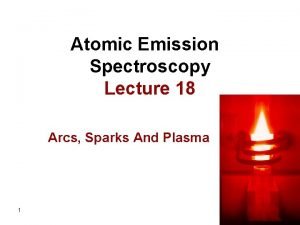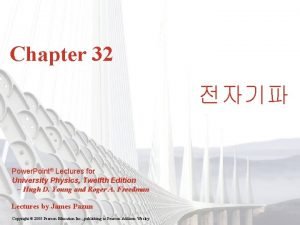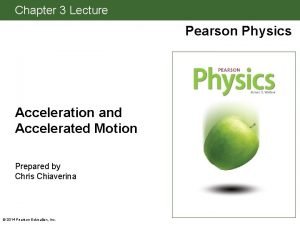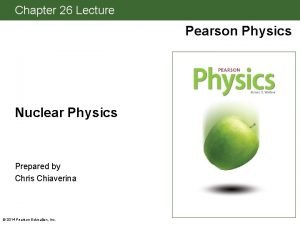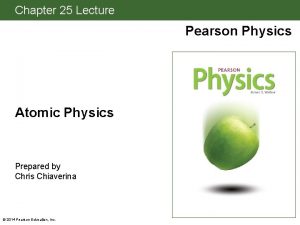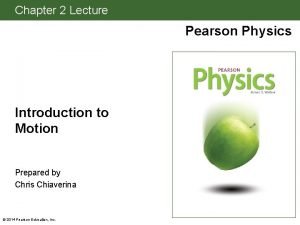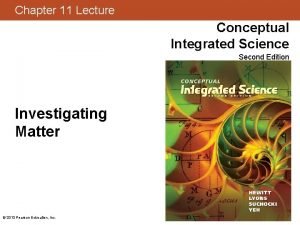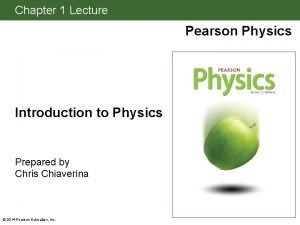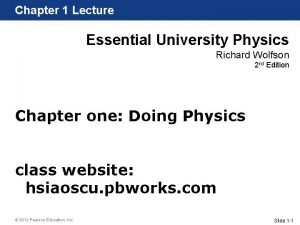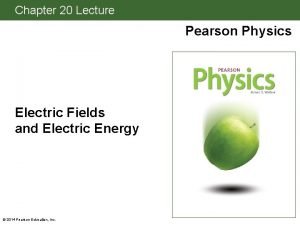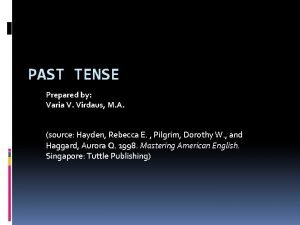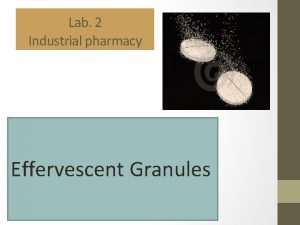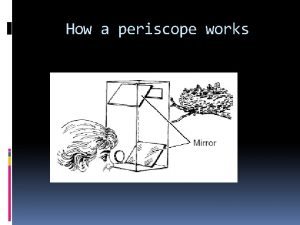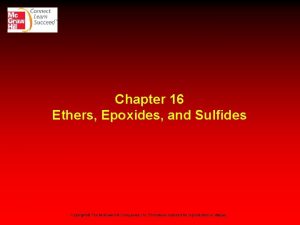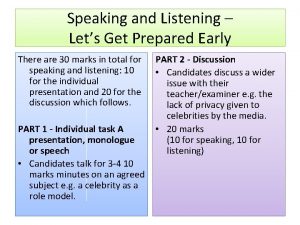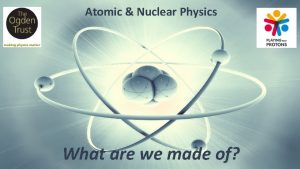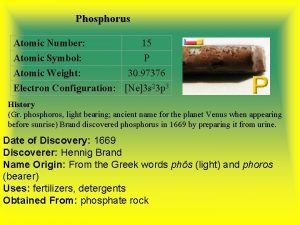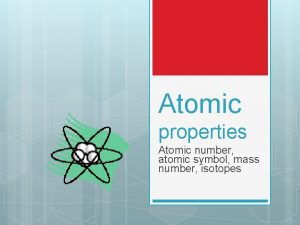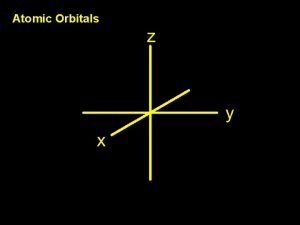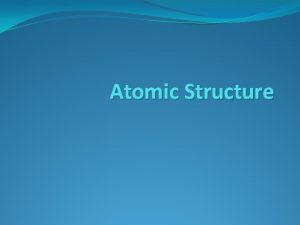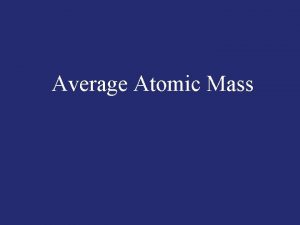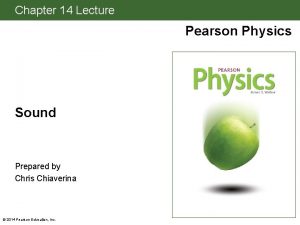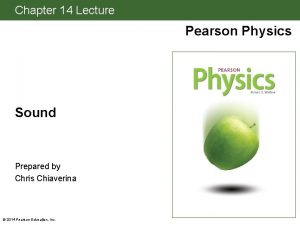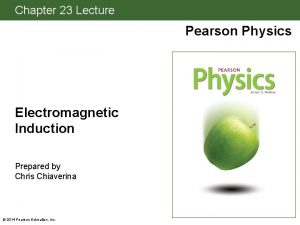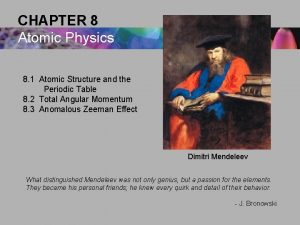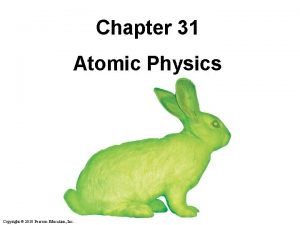Chapter 25 Lecture Pearson Physics Atomic Physics Prepared






































































- Slides: 70

Chapter 25 Lecture Pearson Physics Atomic Physics Prepared by Chris Chiaverina © 2014 Pearson Education, Inc.

Chapter Contents • Early Models of the Atom • Bohr's Model of the Hydrogen Atom • The Quantum Physics of the Atom © 2014 Pearson Education, Inc.

Early Models of the Atom • Speculation about the microscopic structure of matter intrigued people for thousands of years. It took until the late nineteenth century, however, before scientists started unlocking the mystery of the atom. • In 1897 the English physicist J. J. Thomson (1856– 1940) discovered the electron, a particle with a negative charge and smaller in size and thousands of times less massive than the smallest atom. © 2014 Pearson Education, Inc.

Early Models of the Atom • Thompson proposed that atoms, which are electrically neutral, have an internal structure that includes both electrons and positively charged matter. • Thompson's concept of the atom was known as the plum -pudding model. He envisioned negative charges embedded in a more or less uniform distribution of positive charge. The figure below shows the basic idea. © 2014 Pearson Education, Inc.

Early Models of the Atom • Although the plum-pudding model agreed with everything known about atoms at the time, experimental results soon discredited it. • Thomson's findings and other speculations led to further investigations. • In 1909 Ernest Rutherford (1871– 1937) and his coworkers tested Thomson's model by shooting a beam of positively charged alpha particles (the nuclei of helium atoms) at a thin strip of gold foil. © 2014 Pearson Education, Inc.

Early Models of the Atom • With the plum-pudding model in mind, Rutherford expected the following experimental outcomes: – The positively charged alpha particles would be deflected as they passed through the positively charged pudding. – The deflections should be relatively small, since the alpha particles have a substantial mass. – All alpha particles should deflect in roughly the same way since the positive pudding fills virtually all of an atom. © 2014 Pearson Education, Inc.

Early Models of the Atom • The results of the gold-foil experiment did not support these predictions. In fact, most of the alpha particles passed right through the foil—as if it were not there. Could it be that the atoms in the foil were mostly empty space? • This suggestion turned out to be an inspired hunch. When the experiment was repeated, large-angle deflections were observed. In fact, some of the alpha particles were found to have reversed their direction of motion. Rutherford was stunned. © 2014 Pearson Education, Inc.

Early Models of the Atom • Rutherford proposed a new atomic model to account for the experimental results. The model was similar to the Solar System, as is illustrated in the figure below. • Rutherford's model depicted an atom in which lightweight, negatively charged electrons orbit an extremely small but massive nucleus. © 2014 Pearson Education, Inc.

Early Models of the Atom • The nucleus is the region of space at the center of the atom that contains all the atom's positive charge and almost all of its mass. • According to Rutherford's nuclear model, most of an atom is empty space. This explained why the majority of the alpha particles passed right through the gold foil. • Furthermore, the atom's positive charge is highly concentrated in a small nucleus. As a result, an alpha particle that makes a head-on collision with the nucleus can actually be turned around, just as observed in the experiments. © 2014 Pearson Education, Inc.

Early Models of the Atom • Rutherford estimated the diameter of the nucleus to be about 10, 000 times smaller than the diameter of the atom. This means that an atom has an even larger fraction of empty space than the Solar System. • Though the nuclear model seems reasonable, it contains fatal flaws. – One of these is that an orbiting electron experiences a centripetal acceleration toward the nucleus. Because an accelerating charge gives off energy in the form of electromagnetic radiation, an electron radiating energy would spiral inward and eventually plunge into the nucleus. © 2014 Pearson Education, Inc.

Early Models of the Atom – A second flaw has to do with the radiation emitted by the orbiting electron. The frequency of the radiation should be the same as the frequency of the orbit. If electrons spiraled inward, the frequency would increase continuously, and the light emitted by the atom would span a continuous range of frequencies. – This prediction does not agree with experiments, which show that atoms emit only certain discrete frequencies of light. © 2014 Pearson Education, Inc.

Early Models of the Atom • A device known as a gas discharge tube is used to study the light given off by atoms. When a high voltage is applied to the ends of the glass discharge tube, which contains a gas at low pressure, the atoms in the gas become excited and emit electromagnetic radiation. • Passing the radiation through a diffraction grating separates it into its various wavelengths, as is shown in the figure on the next slide. © 2014 Pearson Education, Inc.

Early Models of the Atom • As can be seen in the figure, the result is a series of brightly colored lines. This type of spectrum emitted by atoms, with bright lines at specific frequencies (colors), is referred to as a line spectrum. • In contrast, blackbody radiation is given off over a continuous range of frequencies. © 2014 Pearson Education, Inc.

Early Models of the Atom • This is because blackbody radiation is produced by the blackbody as a whole, and not its individual atoms. A line spectrum, on the other hand, is produced by individual atoms giving off electromagnetic radiation at precise frequencies. • The atoms in the gas inside the gas discharge tube are well separated from one another, and the light they give off is the result of their acting separately. • Atoms have energies that are similar to standing waves on a string. The lines in an atomic spectrum are like the harmonics of a vibrating string. © 2014 Pearson Education, Inc.

Early Models of the Atom • Scientists can learn a lot about atoms from the light they give off. As an example, consider the visible part of the line spectrum of atomic hydrogen in figure (a) below. • The line spectrum shown in the figure is an emission spectrum, since it shows light that is emitted by the hydrogen atom. © 2014 Pearson Education, Inc.

Early Models of the Atom • The absorption spectrum of hydrogen, which is shown in figure (b) below, is formed by passing light of all colors through a tube of hydrogen gas. • As can be seen, light of certain wavelengths is absorbed by the atoms, producing a set of dark lines against an otherwise bright background. • The absorption lines occur at precisely the same wavelengths as the emission lines. © 2014 Pearson Education, Inc.

Early Models of the Atom • The fact that atoms have unique line spectra has led to interesting results and applications. – Helium was first found on the Sun when a spectral line that didn't correspond to any known element on Earth was observed. – A technique known as laser induced breakdown spectroscopy (LIBS) is used to study the chemical composition of materials. In LIBS a short laser pulse vaporizes a sample of a material, creating a plasma of excited atoms. The atoms give off light, with a unique spectral signature for each element. Analyzing the light gives the chemical composition of the sample. © 2014 Pearson Education, Inc.

Bohr's Model of the Hydrogen Atom • Our understanding of the hydrogen atom took a giant leap forward in 1913. In that year Niels Bohr (1885– 1962) introduced a model that allowed him to understand the line spectrum of hydrogen. • Bohr combined the elements of classical physics with the ideas of quantum mechanics. Thus his model is a hybrid that spanned the gap between the physics of Newton and the newly emerging quantum physics. © 2014 Pearson Education, Inc.

Bohr's Model of the Hydrogen Atom • Bohr's model of the hydrogen atom is based on four assumptions. The first two are specific to his model. They are as follows: – The electron in a hydrogen atom moves in a circular orbit about the nucleus. – Only certain circular orbits are allowed. In these orbits the angular momentum of the electron is quantized, just like energy is quantized in Einstein's photon model of light. © 2014 Pearson Education, Inc.

Bohr's Model of the Hydrogen Atom • The next two assumptions are more general: – Electrons do not give off electromagnetic radiation when they are in an allowed orbit. Thus, the orbits are stable. – Electromagnetic radiation is given off or absorbed only when an electron changes from one allowed orbit to another. If the energy difference between the two allowed orbits is ΔE, then the frequency, f, of the photon that is emitted or absorbed is given by ΔE = hf. © 2014 Pearson Education, Inc.

Bohr's Model of the Hydrogen Atom • To summarize, Bohr's model retains the classical picture of an electron orbiting a nucleus. It also adds the quantum requirements that only certain orbits are allowed and no radiation is given off from these orbits. • To determine the allowed Bohr orbits—those with specific radii and specific energies—we apply two conditions. • First, the electron moves in a circular orbit of radius r and speed v, as depicted in the figure on the next slide. © 2014 Pearson Education, Inc.

Bohr's Model of the Hydrogen Atom • As a result, the electron experiences a centripetal acceleration toward the nucleus of magnitude a = v 2/r. • From Newton's second law of motion, we know that a force, F = ma, is required to produce an acceleration. In this case, the force is the electrostatic force F = ke 2/r 2. © 2014 Pearson Education, Inc.

Bohr's Model of the Hydrogen Atom • Combining these results yields the following relationship: F = ma ke 2/r 2 = mv 2/r • Next, Bohr assumed that the angular momentum in an allowed orbit must be an integer n (the quantum number) times h/2π, where h is Planck's constant. Since the electron moves with a speed v in a circular path of radius r, its angular momentum is L = mvr. • Thus this condition is Ln = rnmvn = nh/2π © 2014 Pearson Education, Inc.

Bohr's Model of the Hydrogen Atom • Combining the force and angular momentum equations allows us to solve for the radii of allowed orbits. The result is rn = (h 2/4π2 mke 2)n 2 n = 1, 2, 3, … • Substituting the known values for h, π, m, k, and e yields the following result: © 2014 Pearson Education, Inc.

Bohr's Model of the Hydrogen Atom • The radius of the first Bohr orbit, which corresponds to n = 1, is r 1 = 5. 29 x 10− 11 m • This is known as the Bohr radius. It sets the typical size of a hydrogen atom. The higher orbits in the Bohr model increase in radius as n 2, as indicated in the figure below. © 2014 Pearson Education, Inc.

Bohr's Model of the Hydrogen Atom • The total energy of the hydrogen atom is also quantized. In fact, a straightforward calculation, combing both the kinetic energy ( ) and potential energy (−ke 2/r), shows that the total energy of the nth Bohr orbit is En = −(2π2 mk 2 e 4/h 2)1/n 2 • This simplifies to the following: © 2014 Pearson Education, Inc.

Bohr's Model of the Hydrogen Atom • These energies are plotted in the figure below for various values of n © 2014 Pearson Education, Inc.

Bohr's Model of the Hydrogen Atom • This type of graph is referred to as an energylevel diagram. The ground state (n = 1) of the atom corresponds to its lowest possible energy. • Energy levels above the ground state are referred to as excited states. © 2014 Pearson Education, Inc.

Bohr's Model of the Hydrogen Atom • The figure shows that energy of the excited states approaches zero as the quantum number n becomes infinitely large. Zero is the energy an electron and proton have when separated by an infinite distance. • Thus to ionize an atom—that is, to remove the electron from the atom—requires a minimum energy of 13. 6 e. V. This value, which is a specific prediction of the Bohr model, is in complete agreement with experimental results. © 2014 Pearson Education, Inc.

Bohr's Model of the Hydrogen Atom • The energy values given by the Bohr model agree with the experimentally observed line spectrum of hydrogen. • The basic idea is that when an electron "jumps" from an excited state of hydrogen to a lower energy level, the change in energy is given off as a photon. • If the electron jumps from the n = 3 state to the n = 2 state, for example, the photon that is given off corresponds to the red line shown in the figure on the next slide. © 2014 Pearson Education, Inc.

Bohr's Model of the Hydrogen Atom • The teal green line corresponds to a quantum jump from the n = 4 state to the n = 2 state. • Thus, each possible jump of an electron from one energy state to another results in a different line of the hydrogen spectrum. • This is why hydrogen gives off a line spectrum and not a continuous spectrum. © 2014 Pearson Education, Inc.

Bohr's Model of the Hydrogen Atom • According to Einstein's photon model, the energy of a photon is given by hf. Thus, if the energy of an electron in its initial state is Ei and the energy in its final state is Ef, its change in energy is ΔE = Ef − Ei • The initial and final energies are calculated with En = −(13. 6 e. V)/n 2 using different values of n. • Setting the magnitude of the energy change equal to hf yields hf = |ΔE| © 2014 Pearson Education, Inc.

Bohr's Model of the Hydrogen Atom • It is convenient to calculate the energy of a Bohr orbit in terms of electron volts (e. V), since this is a typical unit of atomic energy. To use the expression hf = |ΔE|, however, the change in energy must be converted to joules (J), using 1. 6 x 10− 19 J = 1 e. V. • Recalling that photons travel at the speed of light, c, a photon's frequency and wavelength are related by c = λf or, equivalently, f = c/λ. © 2014 Pearson Education, Inc.

Bohr's Model of the Hydrogen Atom • Making this substitution allows us to solve for the wavelength of a photon: hc/λ = |ΔE| or λ = hc/|ΔE| • As before, the energy change in this expression must be given in joules. • The example on the following slide illustrates how the wavelength of a photon resulting from a particular quantum jump can be calculated. © 2014 Pearson Education, Inc.

Bohr's Model of the Hydrogen Atom © 2014 Pearson Education, Inc.

Bohr's Model of the Hydrogen Atom © 2014 Pearson Education, Inc.

Bohr's Model of the Hydrogen Atom • Have you ever seen a cat playing on an indoor cat tree, like the one shown in the figure below? © 2014 Pearson Education, Inc.

Bohr's Model of the Hydrogen Atom • The cat can perch on platforms at different levels and jump from one platform to another. The platforms of the cat tree are like the energy levels of the hydrogen atom, and the jumping cat is like an electron making a quantum jump. © 2014 Pearson Education, Inc.

Bohr's Model of the Hydrogen Atom • Just like the cat, an electron can land at different levels, releasing different amounts of energy. The following figure illustrates the situation for hydrogen. © 2014 Pearson Education, Inc.

Bohr's Model of the Hydrogen Atom • Electron jumps that land at the lowest energy level (n = 1) release the most energy—like a cat jumping to the ground. The light that is emitted in these jumps is ultraviolet. • All possible electron jumps that end at n = 1 produce the ultraviolet Lyman series of spectral lines. • All possible electron jumps ending at n = 2 produce the visible Balmer series, and all possible jumps ending at n = 3 produce the infrared Paschen series, and so on. © 2014 Pearson Education, Inc.

Bohr's Model of the Hydrogen Atom • The wavelengths for these first three spectral series are shown in the figure below. © 2014 Pearson Education, Inc.

Bohr's Model of the Hydrogen Atom • The Balmer spectral line corresponding to the electron jump from n = 3 to n = 2 is seen in many astronomical objects. An example is the Lagoon Nebula shown in the figure below. The red light in the photo has a wavelength of 656 nm. © 2014 Pearson Education, Inc.

Bohr's Model of the Hydrogen Atom • The following example illustrates how to determine the frequency of a photon needed to raise an electron in a hydrogen atom from the n = 3 state to the n = 5 state. © 2014 Pearson Education, Inc.

Bohr's Model of the Hydrogen Atom • In 1923 de Broglie used his idea of matter waves (the notion that particles such as electrons have wave properties) to show that one of Bohr's assumptions can be thought of as a condition for standing waves. • Bohr assumed that the angular momentum of an electron in an allowed orbit must be an integer times h/2π. Specifically, rmv = nh/2π • In Bohr's model there is no particular reason for this condition other than it produces results in agreement with experiment. © 2014 Pearson Education, Inc.

Bohr's Model of the Hydrogen Atom • However, de Broglie imagined his matter waves as being analogous to a wave on a string—except that in this case the "string" is not tied at both ends. Instead, it forms a circle of radius r representing an electron's orbit about the nucleus, as is illustrated in the figure below. © 2014 Pearson Education, Inc.

Bohr's Model of the Hydrogen Atom • The condition for a standing wave in this case is that an integer number of wavelengths will fit into the circumference of the orbit. Stated mathematically, the condition is • Figure (a) above shows the cases corresponding to seven and eight wavelengths fitting around the circumference. Other intermediate wavelengths result in destructive interference [figure (b)]. © 2014 Pearson Education, Inc.

Bohr's Model of the Hydrogen Atom • The figure below shows a mechanical analogy for de Broglie waves in hydrogen. A loop of wire is oscillated vertically about the support point at the bottom of the loop. The oscillations set up standing waves on the circumference of the loop—like de Broglie waves on a Bohr orbit in hydrogen. © 2014 Pearson Education, Inc.

Bohr's Model of the Hydrogen Atom • de Broglie combined the condition for standing waves, nλ = 2πr, with his expression for the wavelength of matter, λ = h/p. Since the linear momentum is p = mv, the standing wave condition can be written as follows: nλ = 2πr nh/mv = 2πr • A simple rearrangement yields rmv = nh/2π. This is precisely Bohr's orbital condition. • Thus, matter wave are seen to have a direct connection to physics on the atomic level. © 2014 Pearson Education, Inc.

The Quantum Physics of Atoms • While the Bohr model works well in describing hydrogen, attempts to extend it to other atoms failed. Clearly, the Bohr model isn't the full story. • For example, the Bohr model does not explain why an accelerating electron in a circular orbit gives off no radiation. • Bohr's assumption that an orbiting electron has a well-defined momentum means, according to the Heisenberg uncertainty principle, that its position should be completely unknown. © 2014 Pearson Education, Inc.

The Quantum Physics of Atoms • All these questions and inconsistencies were resolved by Erwin Schrӧdinger (1887– 1961), who developed a whole new approach to quantum physics. • Schrӧdinger used de Broglie's idea of matter waves to develop an equation that describes their behavior. • The Schrӧdinger equation applies to all atoms—not just hydrogen—and is completely consistent with the uncertainty principle. • Schrӧdinger's equation plays the same role in quantum physics as Newton's laws in classical mechanics and Maxwell's equations in electromagnetism. © 2014 Pearson Education, Inc.

The Quantum Physics of Atoms • The solution to the Schrӧdinger equation is a wave function that gives the probability of finding the electron in a given location. • Now here's an very important point: The wave function doesn't tell you where the electron is— as is the case in classical physics—it tells you the probability that the electron is here, or there, or someplace else. • To visualize a wave function, think of it as a probability cloud. © 2014 Pearson Education, Inc.

The Quantum Physics of Atoms • The figure below shows the probability cloud for the ground state of hydrogen. • Interpreting a probability cloud is simple—the electron is most likely to be found where the cloud is most dense. For the cloud in the above figure, the highest probability is in the dark band, which is actually a spherical shell. • Notice that the probability of finding the electron near the nucleus, or far from it, is small. © 2014 Pearson Education, Inc.

The Quantum Physics of Atoms • Probability clouds for excited states of hydrogen have the same interpretation as that for the ground state, but their shapes are more interesting. • For example, a probability cloud for the first excited state of hydrogen is shown in the figure below. © 2014 Pearson Education, Inc.

The Quantum Physics of Atoms • Notice that there are two distinct clouds in this case, separated by a node—a plane of zero probability. © 2014 Pearson Education, Inc.

The Quantum Physics of Atoms • A node on a string is a location of zero displacement; a node on a wave function is a location of zero probability. • Just as standing waves on a string have more and more nodes as the frequency of the wave increases, probability clouds have more and more nodes as the energy goes up. © 2014 Pearson Education, Inc.

The Quantum Physics of Atoms • The matter-wave physics described by Schrӧdinger's equation is known as quantum mechanics to distinguish it from the classical mechanics of Newton's laws of motion. • Quantum mechanics is the most thoroughly tested theory in the history of science. It applies to everything in the physical world, from atoms to molecules, solids to liquids, metals to semiconductors. • The technological advances of modern society are primarily a result of our ability to understand apply quantum mechanics. © 2014 Pearson Education, Inc.

The Quantum Physics of Atoms • One of the most important applications of quantum mechanics is the development of a new way to produce light: the laser. • Lasers produce light that is intense, travels in one direction, and has a single, pure color. • Because of these properties, lasers are used in a multitude of technological applications, ranging from supermarket scanners to CD players, from laser pointers to eye surgery. © 2014 Pearson Education, Inc.

The Quantum Physics of Atoms • The word laser is an acronym for light amplification by the stimulated emission of radiation. • To understand how a laser works, consider two energy levels in an atom. An electron left alone in an excited state will eventually drop to a lower state in a time that is about 10− 8 s, giving off a photon in the process. This is referred to as spontaneous emission. © 2014 Pearson Education, Inc.

The Quantum Physics of Atoms • In a laser the excited-state electron is not left alone. Instead, a photon with an energy equal to the energy difference between the two energy levels passes near the electron. The photon increases the probability that the electron will drop to the lower level. That is, the incident photon can stimulate the emission of a photon by the electron. • The photon given off in this process of stimulated emission has the same energy and the same phase and travels in the same direction as the incident photon. © 2014 Pearson Education, Inc.

The Quantum Physics of Atoms • The process of stimulated emission is illustrated in the figure below. • A single photon encountering an excited atom can cause two identical photons to exit the atom. If each of these two photons encounters another excited atom and undergoes the same process, the number of photons increases to four. © 2014 Pearson Education, Inc.

The Quantum Physics of Atoms • Continuing in this manner, the photons undergo a chain reaction that doubles their number with each generation. It is this property of stimulated emission that results in light amplification. • In order for the light amplification process to work, photons must continue to encounter atoms with electrons in excited states. Thus, for laser action to occur, atoms must first be raised to an excited state. © 2014 Pearson Education, Inc.

The Quantum Physics of Atoms • A specific example of a laser is the helium-neon laser, shown schematically in the figure below. © 2014 Pearson Education, Inc.

The Quantum Physics of Atoms • The laser consists of a glass tube containing helium and neon atoms. The tube has a reflecting mirror at one end a semitransparent mirror at the other end. • A high voltage applied to the ends of the tube causes electrons and helium atoms to move through the tube, colliding with neon atoms and exciting them until they emit light. • Light bounces back and forth between the mirrors, increasing in intensity as it stimulates more and more atoms to emit light. Eventually the amplified light exits through the semitransparent mirror. © 2014 Pearson Education, Inc.

The Quantum Physics of Atoms • As was mentioned previously, lasers have many applications. • One medical application of lasers is in laser eye surgery. In such surgery a laser that emits high-energy photons in the ultraviolet range is used to reshape the cornea and correct nearsightedness. • In LASIK eye surgery, a flap of the cornea is cut and folded back. Next, a UV laser is used to vaporize some of the underlying corneal material. When the flap is replaced, the cornea is flatter than it was originally, correcting the patient's nearsightedness. • The process is illustrated in the figure on the next slide. © 2014 Pearson Education, Inc.

The Quantum Physics of Atoms • Lasers are also used to produce three-dimensional images known as holograms. A hologram is a true three-dimensional image, as the figure below indicates. © 2014 Pearson Education, Inc.

The Quantum Physics of Atoms • Have you ever wondered how a fluorescent lightbulb works? As its name implies, a fluorescent lightbulb makes use of a phenomenon known as fluorescence. • As the figure below shows, fluorescence is the emission of light of a lower frequency by a material that has been illuminated by light of a higher frequency. © 2014 Pearson Education, Inc.

The Quantum Physics of Atoms • A fluorescent lightbulb uses fluorescence to convert high-frequency UV light to lower frequency visible light. • The bulb consists of a sealed tube filled with mercury vapor. When electricity is applied to the ends of the tube, a filament is heated, producing electrons. These electrons are then accelerated though the tube with an applied voltage. • When the electrons strike the mercury atoms in the tube, the atoms become excited and then give off UV light as they decay to their ground state. © 2014 Pearson Education, Inc.

The Quantum Physics of Atoms • The inside of the tube is coated with a material known as a phosphor. The phosphor coating absorbs the UV light and then emits lowerfrequency visible light. • Fluorescence finds many less familiar applications. In forensics, the analysis of a crime scene is enhanced by the fact that human bones and teeth are fluorescent. Thus, illuminating a crime scene with UV light can make items of interest stand out for easy identification. © 2014 Pearson Education, Inc.

The Quantum Physics of Atoms • In addition, the use of fluorescent dye can make fingerprints clearly visible, as shown in the figure below. • Many creatures produce fluorescence in their bodies. For example, several types of coral glow brightly when illuminated with UV light. Scorpions are also strongly fluorescent, as shown in the figure on the next slide. © 2014 Pearson Education, Inc.

The Quantum Physics of Atoms © 2014 Pearson Education, Inc.
 01:640:244 lecture notes - lecture 15: plat, idah, farad
01:640:244 lecture notes - lecture 15: plat, idah, farad Atomic emission spectroscopy lecture notes
Atomic emission spectroscopy lecture notes Relative formula mass of hcl
Relative formula mass of hcl What are the trends on the periodic table
What are the trends on the periodic table Small atomic radius
Small atomic radius Atomic mass of oxygen
Atomic mass of oxygen Atomic mass and atomic number difference
Atomic mass and atomic number difference Atomic number vs atomic radius
Atomic number vs atomic radius Prentice hall publishing
Prentice hall publishing 2011 pearson education inc
2011 pearson education inc Pearson vue ceo
Pearson vue ceo Educational pearson pearson times
Educational pearson pearson times Pearson education inc publishing as pearson prentice hall
Pearson education inc publishing as pearson prentice hall Pearson education inc publishing as pearson prentice hall
Pearson education inc publishing as pearson prentice hall Pearson education inc publishing as pearson prentice hall
Pearson education inc publishing as pearson prentice hall Classical mechanics
Classical mechanics Physics 101 lecture
Physics 101 lecture Phy101 lecture 1
Phy101 lecture 1 Physics 101 lecture notes pdf
Physics 101 lecture notes pdf What is wave motion
What is wave motion Atmospheric physics lecture notes
Atmospheric physics lecture notes Database processing 15th edition
Database processing 15th edition Pearson physics
Pearson physics Xf=xi+vt
Xf=xi+vt Chain physics
Chain physics Pearson physics
Pearson physics Pearson physics
Pearson physics Conceptual integrated science
Conceptual integrated science Pearson physics
Pearson physics Pearson physics
Pearson physics Pearson
Pearson The business plan should be prepared by
The business plan should be prepared by After a node has prepared an lsp it must be disseminated to
After a node has prepared an lsp it must be disseminated to How does juliet regain her parents' favor
How does juliet regain her parents' favor Conclusion of periscope
Conclusion of periscope Temporary hair color milady
Temporary hair color milady Wet land preparation
Wet land preparation Method of departmental accounting
Method of departmental accounting List three examples of in-transit foodservice operations
List three examples of in-transit foodservice operations Charred document example
Charred document example Gayne corporation's contribution margin ratio
Gayne corporation's contribution margin ratio Pokmijnuhbygvtfcrdxeszwaq
Pokmijnuhbygvtfcrdxeszwaq Storm on the island
Storm on the island Liquid dosage form example
Liquid dosage form example Preparatory consulting social work
Preparatory consulting social work Be prepared to give an answer
Be prepared to give an answer Be prepared to give an answer
Be prepared to give an answer Rpd rest seat preparation
Rpd rest seat preparation Benefits of bsn-prepared nurses
Benefits of bsn-prepared nurses Past form of prepared
Past form of prepared Fusion method pharmaceutics
Fusion method pharmaceutics Example of textual sermon
Example of textual sermon Periscope explanation
Periscope explanation In williamson’s synthesis, ethoxyethane is prepared by-
In williamson’s synthesis, ethoxyethane is prepared by- Installment liquidation meaning
Installment liquidation meaning Be prepared to share the hope
Be prepared to share the hope How standard costs are prepared
How standard costs are prepared Let's get prepared
Let's get prepared Project client name
Project client name Award prepared
Award prepared Trading account example
Trading account example Centralized foodservice system
Centralized foodservice system Percolator diagram in pharmacy
Percolator diagram in pharmacy Ezra prepared his heart
Ezra prepared his heart Bad debts written off sales ledger control account
Bad debts written off sales ledger control account Wake county prepared food tax
Wake county prepared food tax Prepared exclusively for
Prepared exclusively for Preparation of ointment by fusion method
Preparation of ointment by fusion method Past simple
Past simple Casseroling
Casseroling Project prepared by
Project prepared by

